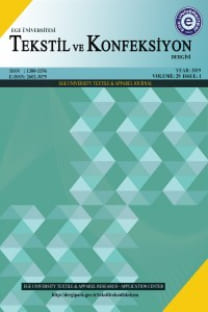A Hydrophilic/Hydrophobic Composite Structure for Water Harvesting from the Air
A Hydrophilic/Hydrophobic Composite Structure for Water Harvesting from the Air
water harvesting, hydrophilic, hydrophobic electrospinning, electrospraying,
___
- Claire, S.,2002, The Last Drop. Mazaya Summer Issue, 22–25. 2.
- Eslami, M., Tajeddini, F., Etaati, N., 2018, Thermal analysis and optimization of a system for water harvesting from humid air using thermoelectric coolers. Energy Convers. Manag., 174, 417–429.
- Alkaisi, A., Mossad, R., Sharifian-Barforoush, A.,2017, A review of the water desalination systems integrated with renewable energy. Energy Proc.,110, 268-274. Park K.C, Chhatre S.S, Srinivasan S., Cohen R.E., McKinley G.H., 2013, Optimal design of permeable fiber network structures for fog harvesting. Langmuir, 29, (43), 13269–13277.
- https://www.smithsonianmag.com/science-nature/five-wild-ways-get-drink-desert-180952845/ (Accessed: 08.07.2021)
- Parker, A.R., Lawrence, C.R.,2001, Water capture by a desert beetle. Nature, 414, (6859), 33–34.
- Zhai, L., Berg, M.C., Cebeci, F.C., Kim, Y., Milwid, J.M., Rubner, M.F., Cohen, R.E.,2006, Patterned superhydrophobic surfaces: toward a synthetic mimic of the Namib Desert beetle. Nano Lett.,6, 1213–1217.
- Huang, Z.X., Liu, X., Wu, J., Wong, S.C., Qu, J.P., 2017, Electrospinning water harvesters inspired by spider silk and beetle. Mater. Lett., 211, 28–31.
- Huang, Z.X., Liu, X., Wong, S.C., Qu, J.P.,2019, A single step fabrication of bio-inspired high efficiency and durable water harvester made of polymer membranes. Polymer, 183.
- Garrod, R., Harris, L., Schofield, W., McGettrick, J., Ward, L., Teare, D., Badyal, J., 2007, Mimicking a Stenocara Beetle’s back for microcondensation using plasmachemical patterned superhydrophobic superhydrophilic surfaces. Langmuir, 23, (2), 689–693.
- Feng, L., Li, S., Li, Y., 2002, Super-hydrophobic Surface: from Natural to Artificial, Advanced Materials, 14(24), 1857–1860
- Kenneth, K., S., Lau José Bico Kenneth, B., K., Teo Manish Chhowalla Gehan A. J. Amaratunga William I. Milne Gareth H. McKinley Karen K. Gleason, 2003, Superhydrophobic Carbon Nanotube Forests, Nano Letters, 3, 12, 1701-1705
- Ghosh R., Ray T., Ganguly R., 2015, Cooling tower fog harvesting in power plants e A pilot study, Energy, 89, 1018-1028
- Knapczyk-Korczak, J., Szewczyk, P. K., Ura, D. P., Berent, K., Stachewicz, U., 2020, Hydrophilic nanofibers in fog collectors for increased water harvesting efficiency, The Royal Society of Chemistry ,10, 22335–22342
- Nirmala, A., Navamathavan, R., Kang, H.,S., El- Newehyd, M.,H., Kim, H.,Y., 2011, Preparation of polyamide-6/chitosan composite nanofibers by a single solvent system via electrospinning for biomedical applications, Colloids and Surfaces B: Biointerfaces, 83, 173–178.
- Martinová, L., Lubasová, D., 2008, Electrospun chitosan based nanofibers, RJTA., 12(2), 72-79
- Woodruff, M., A., Hutmacher, D., W., 2010, The return of a forgotten polymer Polycaprolactone in the 21st century. Progress in Polymer Science journal, 1217-1256
- ISSN: 1300-3356
- Yayın Aralığı: 4
- Yayıncı: Ege Üniversitesi Tekstil ve Konfeksiyon Araştırma & Uygulama Merkezi
Şeyda TOPALOĞLU YILDIZ, Gülseren KARABAY
Investigation of Performance Properties of Denim Fabrics Containing Cotton/Sustans® Blend Rotor Yarn
Muhittin ÖZKAN, Pınar DURU BAYKAL, İlkan ÖZKAN
Yordan KYOSEV, Alexander REİCH
Halil İbrahim ÇELİK, Lale Canan DÜLGER, Burak ÖZTAŞ, Mehmet KERTMEN, Elif GÜLTEKİN
Design and Implementation of a Textile-Based Embroidered Frequency Selective Surface
İbrahim ÜNER, Sultan CAN, Banu Hatice GÜRCÜM, Asım Egemen YILMAZ, Ertugrul AKSOY
A Vibro-Haptics Smart Corset Trainer for Non-Ideal Sitting Posture
Mehmet Arda ÖZDEN, Eda ACAR, Hasan YILDIZ, Mücella GÜNER, Mahmut PEKEDİS
A Study on the Strength Properties of Various Buttons Used in Garments
Nilgün ÖZDİL, Esra Zeynep YILDIZ, Gamze SÜPÜREN MENGÜÇ, Oktay PAMUK
A Hydrophilic/Hydrophobic Composite Structure for Water Harvesting from the Air
